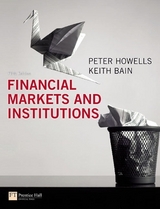
Financial Markets and Institutions
Financial Times Prentice Hall (Verlag)
9780273682837 (ISBN)
- Titel erscheint in neuer Auflage
- Artikel merken
For a thorough understanding of the financial activity that is so widely and prominently reported in the media, it is vital that students are able to grasp the theory and principles of the subject. With its clear and accessible exposition, this text will help students make sense of the workings of financial markets and institutions. Theory is covered only where absolutely necessary and to help students understand events as they happen in the real world, the book takes a practical, applied approach.The fourth Edition of Financial Markets and Institutions has been thoroughly updated to reflect the changes that have occurred in the financial system in recent years. The book looks at financial activity from the economist's perspective, discussing its origin in the real economy and the need to lend and borrow to enable real investment to take place. The book also considers the shortcomings of financial markets and markets and the effect the shortcomings have on the real economy.
Preface xii Acknowledgements and Companion Web Site information xiii Terms used in equations xiv 1 Introduction: the financial system 1 1.1 Financial institutions 3 1.1.1 Financial institutions as firms 3 1.1.2 Financial institutions as 'intermediaries' 5 1.1.3 The creation of assets and liabilities 6 1.1.4 Portfolio equilibrium 14 1.2 Financial markets 16 1.2.1 Types of product 16 1.2.2 The supply of financial instruments 19 1.2.3 The demand for financial instruments 19 1.2.4 Stocks and flows in financial markets 21 1.3 Lenders and borrowers 22 1.3.1 Saving and lending 22 1.3.2 Borrowing 24 1.3.3 Lending, borrowing and wealth 25 1.4 Summary 26 Questions for discussion 27 Further reading 27 Appendix: Portfolio theory 28 2 The financial system and the real economy 46 2.1 Lending, borrowing and national income 47 2.2 Financial activity and the level of aggregate demand 54 2.2.1 Money and spending 54 2.2.2 Liquid assets and spending 56 2.2.3 Financial wealth and spending 57 2.3 The composition of aggregate demand 58 2.4 The financial system and resource allocation 60 2.5 Summary 62 Questions for discussion 63 Further reading 64 Answers to exercises 64 3 Deposit-taking institutions 65 3.1 The Bank of England 68 3.1.1 The conduct of monetary policy 69 3.1.2 Banker to the commercial banking system 71 3.1.3 Banker to the government 72 3.1.4 Supervisor of the banking system 73 3.1.5 Management of the national debt 74 3.1.6 Manager of the foreign exchange reserves 75 3.1.7 Currency issue 75 3.2 Banks 76 3.3 Banks and the creation of money 78 3.3.1 Why banks create money 79 3.3.2 How banks create money 81 3.4 Constraints on bank lending 86 3.4.1 The demand for bank lending 86 3.4.2 The demand for money 87 3.4.3 The monetary base 88 3.5 Building societies 94 3.6 Liability management 101 Questions for discussion 104 Further reading 104 Answers to exercises 105 Appendix: A history of UK monetary aggregates 106 4 Non-deposit-taking institutions 108 4.1 Insurance companies 110 4.2 Pension funds 116 4.3 Unit trusts 120 4.4 Investment trusts 124 4.5 NDTIs and the flow of funds 127 4.6 'Short-termism' and other criticisms 129 4.7 Summary 134 Questions for discussion 135 Further reading 135 5 The money markets 137 5.1 The discount market 140 5.2 The 'parallel' markets 149 5.2.1 The interbank market 149 5.2.2 The market for certificates of deposit 150 5.2.3 The commercial paper market 153 5.2.4 The local authority market 153 5.2.5 Repurchase agreements 154 5.2.6 The euromarkets 154 5.2.7 The significance of the parallel markets 156 5.3 Monetary policy and the money markets 159 5.4 Summary 166 Questions for discussion 166 Further reading 167 Answers to exercises 168 6 The capital markets 169 6.1 The importance of capital markets 170 6.2 Characteristics of bonds and equities 171 6.2.1 Bonds 171 6.2.2 Equities 175 6.2.3 The trading of bonds and equities 177 6.3 The supply of bonds and equities 184 6.4 The demand for bonds and equities 187 6.4.1 The demand for bonds 187 6.4.2 The demand for equities 196 6.5 The behaviour of security prices 203 6.6 Reading the financial press 213 6.7 Summary 218 Questions for discussion 219 Further reading 219 Answers to exercises 220 Interest rates 221 7.1 The rate of interest 222 7.1.1 Nominal and real rates of interest 222 7.2 The loanable funds theory of real interest rates 224 7.2.1 Problems with the loanable funds theory and the Fisher effect 228 7.3 Loanable funds in an uncertain economy 231 7.4 The liquidity preference theory of interest rates 233 7.5 Loanable funds and liquidity preference 235 7.6 The monetary authorities and the rate of interest 236 7.6.1 Loanable funds, liquidity preference and monetary policy 239 7.7 The structure of interest rates 240 7.7.1 The term structure of interest rates 242 7.7.2 The pure expectations theory of interest rate structure 242 7.7.3 Term premiums 243 7.7.4 Market segmentation 248 7.7.5 Preferred habitat 249 7.7.6 A summary of views on maturity substitutability 249 7.8 The significance of term structure theories 249 7.9 Summary 251 Questions for discussion 252 Further reading 252 Answers to exercises 253 8 Foreign exchange markets 254 8.1 The nature of forex markets 255 8.2 The efficient markets hypothesis 259 8.3 Interest rate parity 262 8.4 Other foreign exchange market rules 267 8.4.1 Differences in interest rates among countries -- the Fisher effect 267 8.4.2 The determinants of spot exchange rates -- purchasing power parity 268 8.4.3 Market efficiency and the forex markets 268 8.5 Alternative views of forex markets 270 8.5.1 Exchange rate overshooting and rational bubbles 270 8.5.2 Irrationality and diverse expectations 272 8.6 Fixed exchange rate systems 274 8.7 Monetary union in Europe 275 8.7.1 The early travails of the euro 279 8.7.2 The UK and the euro 280 8.8 Summary 281 Questions for discussion 282 Further reading 283 Answers to exercises 284 9 Exchange rate risk, derivatives markets and speculation 285 9.1 Forms of exposure to exchange rate risk 286 9.2 Exchange rate risk management techniques 288 9.3 Derivatives markets 289 9.3.1 Financial futures 290 9.3.2 Options 297 9.3.3 Exotic options 302 9.4 Comparing different types of derivatives 303 9.4.1 Exchange-traded derivatives versus OTC products 303 9.4.2 Forward versus futures contracts 303 9.4.3 Forward and futures contracts versus options 304 9.5 The use and abuse of derivatives 306 9.6 Summary 309 Questions for discussion 309 Further reading 310 Answers to exercises 311 10 International capital markets 312 10.1 The world capital market 313 10.2 Eurocurrencies 314 10.2.1 The growth of the eurocurrency markets 316 10.2.2 The nature of the market 318 10.2.3 Issues relating to eurocurrency markets 320 10.3 Techniques and instruments in the eurobond and euronote markets 322 10.4 The damaging effects of international markets? Controversies for the millennium 329 10.5 Summary 330 Questions for discussion 331 Further reading 332 11 Government borrowing and financial markets 333 11.1 The measurement of public deficits and debt 334 11.2 Financing the PSNCR 341 11.2.1 The PSNCR and interest rates 341 11.2.2 The sale of bonds to banks 346 11.2.3 The sale of bonds overseas 347 11.2.4 PSNCR, interest rates and the money supply -- a conclusion 348 11.3 The public debt and open market operations 351 11.4 Debt management and interest rate structure 352 11.5 Summary 353 Questions for discussion 354 Further reading 355 Answers to exercises 355 12 The regulation of financial markets 357 12.1 The theory of regulation 360 12.2 Financial regulation in the UK 362 12.2.1 Regulatory changes in the 1980s 364 12.2.2 Supervision of the banking system 369 12.2.3 The 1998 reforms 372 12.3 The European Union and financial regulation 375 12.3.1 Regulation of the banking industry in the EU 378 12.3.2 Regulation of the securities markets in the EU 379 12.3.3 The regulation of insurance services in the EU 382 12.4 The problems of globalisation and the growing complexity of derivatives markets 384 12.5 Summary 389 Questions for discussion 390 Further reading 390 Appendix Present and future value tables 393 Index 398
| Erscheint lt. Verlag | 25.2.2004 |
|---|---|
| Verlagsort | Harlow |
| Sprache | englisch |
| Maße | 189 x 249 mm |
| Gewicht | 736 g |
| Themenwelt | Wirtschaft ► Betriebswirtschaft / Management ► Finanzierung |
| Wirtschaft ► Volkswirtschaftslehre ► Finanzwissenschaft | |
| ISBN-13 | 9780273682837 / 9780273682837 |
| Zustand | Neuware |
| Informationen gemäß Produktsicherheitsverordnung (GPSR) | |
| Haben Sie eine Frage zum Produkt? |
aus dem Bereich



